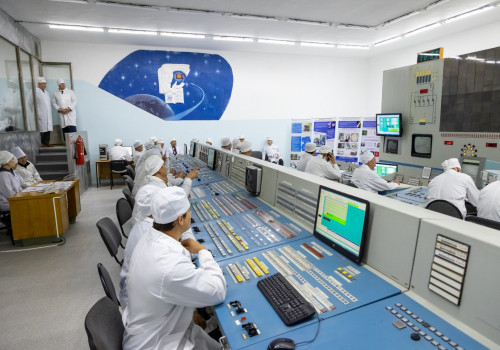 The IVG.1M research reactor at Kazakhstan’s National Nuclear Centre (NNC) in Kurchatov, has resumed formal operation using low-enriched uranium (LEU) fuel, following completion its conversion and subsequent licensing.
The IVG.1M research reactor at Kazakhstan’s National Nuclear Centre (NNC) in Kurchatov, has resumed formal operation using low-enriched uranium (LEU) fuel, following completion its conversion and subsequent licensing.
Following the start-up, a round table, “Power Startup of IVG.1M Reactor with LEU fuel: Achievements and Prospects”, was held attended by the Ministry of Energy; Canadian Ambassador Alan Hamson; the Director for the Office of Conversion at the US National Nuclear Security Administration, Christopher Landers; representatives of the US Embassy to Kazakhstan; and representatives of Kazakh and US scientific organisations. They noted that the conversion had not only resulted in an upgraded reactor using LEU fuel, but had also considerably improve the technical condition of reactor and auxiliary systems, as well as the infrastructure of Baikal-1 complex in Kurchatov.
NNC said the IVG.1M reactor is now ready to continue experiments and renewed research within its budgetary and commercial programmes. Recent research at the reactor has included studies on ITER structural material interaction with hydrogen and its isotopes under reactor irradiation condition, as well as the study of reactor radiation scattering in the atmosphere to validate the safety of nuclear power.
The water-cooled IVG.1M reactor began operation in 1992 following modernisation of the high-temperature gas-cooled IVG.1 reactor, which began operation in 1975. IVG.1 was originally intended for testing fuel rods and fuel assemblies. During that upgrade, the gas-cooled reactor core was replaced with a water-cooled core.
Like many other research reactors, IVG.1M originally used highly enriched uranium (HEU), which is now considered a proliferation risk. Since 1978, international agreements supported by the International Atomic Energy Agency (IAEA) on the conversion of research reactors to LEU fuel have been signed by various countries to address these problems. Kazakhstan signed such an agreement in the early 2000s and a conversion project was launched in 2010 to reduce fuel enrichment to below 20% in accordance with IAEA requirements, while maintaining and improving its performance. NNC specialists, together with American and Russian partners, undertook computational and analytical justification for planned conversion. By the end of 2013, this work had been completed confirming its feasibility.
In 2014, two experimental channels with LEU fuel manufactured by Russia’s FSUE SIA LUCH (chief IVG.1M fuel designer) were supplied for reactor testing and adaptation which continued until 2016. Reactor tests took place from 2017 to October 2019 and were completed after reaching the target operating time of 1080 MWh, with a total of 49 reactor start-ups.
In September 2020, Kazakhstan and the USA signed a joint statement in which they committed to converting the IVG.1M research reactor from HEU to LEU fuel in 2021. The first technological channel with LEU fuel was loaded into the reactor in March 2022. NNC announced in May 2022 that workers at Kurchatov had successfully performed the physical start-up of the IVG.1M reactor using the new LEU fuel. Power start-up began in November 2022.
US-Kazakh collaboration has also resulted in conversion of the VVR-K reactor at the Institute of Nuclear Physics in Almaty, including the downblending of 49.3kg of unirradiated HEU and the removal of 158.3kg of irradiated HEU. Currently, NNC and the US Argonne National Laboratory are studying the possibility of converting the IGR at Kurchatov to use LEU fuel. Work on down-blending fresh HEU fuel for the IGR reactor at the Ulba Metallurgical Plant has already been completed, and preparations underway to also downblend irradiated HEU fuel from this reactor.
NNC was found in 1993 based on the Joint Expedition of NPO Luch, which was established in 1958 in the Soviet Union by the Institute of Atomic Energy, the Kurchatov Institute and the Podolsk Research Technological Institute. At that time, the focus was on development of nuclear rocket engines (NRE) for ballistic and space rockets. For NRE testing, a bench base of NPO Luch was created, including the IGR and Baikal-1 research reactor complexes in Kazakhstan. Work on NREs and NPPs was carried out until 1989.
Image: The IVG.1M research reactor control room (courtesy of NNC)






